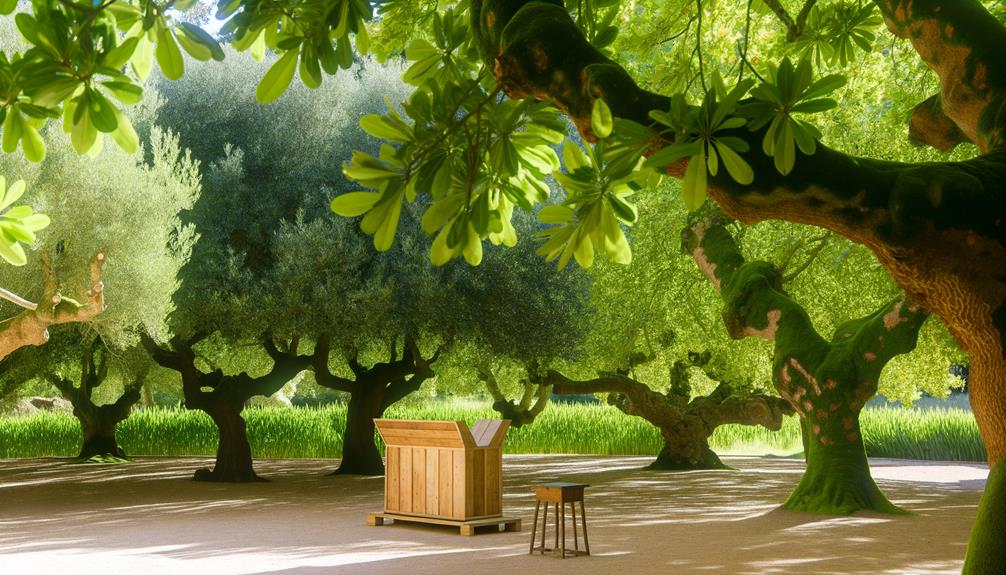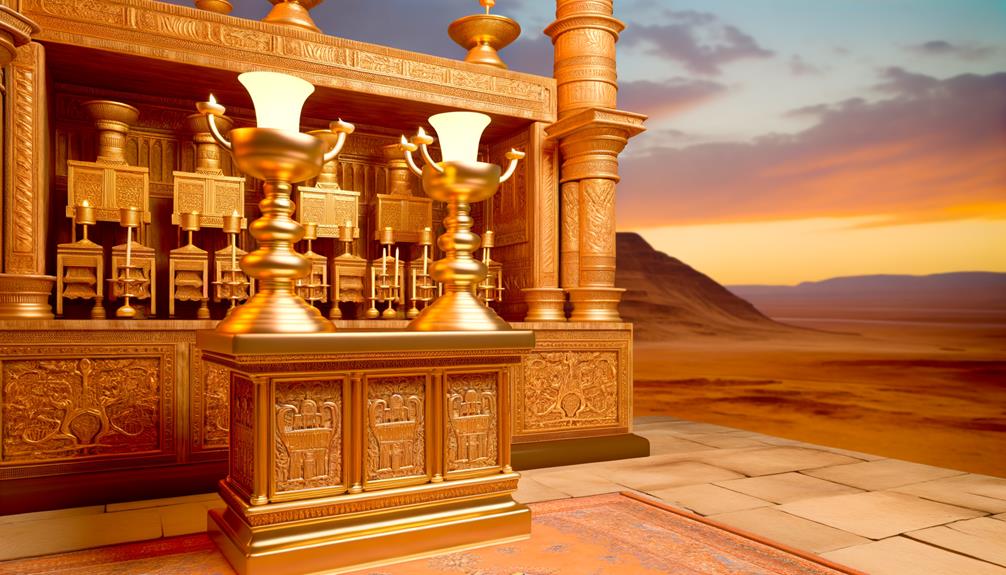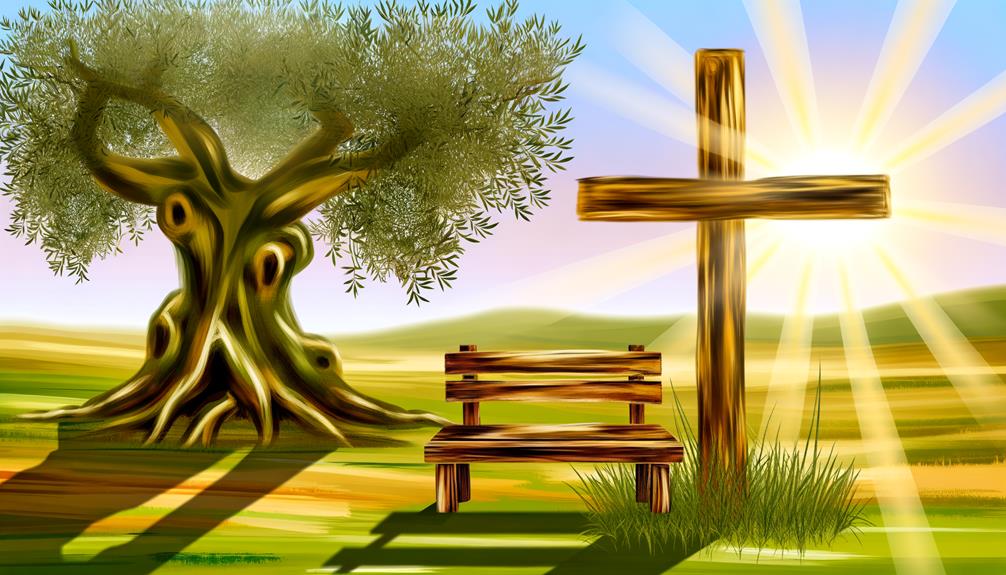Meaning of Wood in the Bible: Strength and Sacrifice
In the Bible, wood embodies profound themes of life, divine presence, and sacrifice. The Tree of Life in Genesis symbolizes eternal growth, while the Ark of Noah, built from gopher wood, signifies divine salvation.
The Tabernacle’s acacia wood highlights sacredness, and Solomon’s Temple’s cedar wood denotes God’s enduring presence. Most importantly, the wooden cross of Christ epitomizes sacrifice and redemption.
Wood also serves as a metaphor for spiritual growth and resilience, as seen in the teachings of Jesus and prophetic visions. Exploring these themes reveals deeper insights into biblical narratives and God’s relationship with humanity.

Key Takeaways
- Wood symbolizes life, growth, and divine provision, as seen in the Tree of Life and various trees throughout biblical narratives.
- Wooden structures like the Ark, Tabernacle, and Solomon’s Temple represent divine presence and connection with humanity.
- The wooden cross of Christ symbolizes sacrifice, redemption, and divine love, central to Christian faith.
- Wood represents endurance and resilience, evidenced by Noah’s Ark and the Cross, signifying divine protection and unwavering faith.
Wood in Genesis

In the Book of Genesis, wood plays a significant role both symbolically and functionally, most importantly in the construction of Noah’s Ark. The wood used in Genesis often symbolizes life, renewal, and divine provision.
For instance, the trees in the Garden of Eden are not mere flora; they represent knowledge, sustenance, and the boundary between obedience and sin.
Historically, wood’s role in ancient societies as a primary building material underscores its importance in biblical narratives.
Scripturally, wood serves as a tangible connection between humanity and the divine, as seen in the altars erected by patriarchs like Abraham. These wooden structures were not just physical constructs but also deeply spiritual symbols, reflecting God’s covenant and presence among His people.
The Ark of Noah

Constructed from gopher wood, the Ark of Noah serves as a profound proof of divine salvation and judgment, illustrating God’s covenantal promise amidst a world engulfed in moral corruption.
In Genesis 6:14, God commands Noah, a righteous man in a corrupt generation, to build the Ark as a refuge from the impending flood. This wood symbolizes preservation and obedience to divine instruction.
The Ark’s construction specifications, meticulously outlined by God, underscore a theological narrative of redemption and judgment. Historically, the Ark is a vessel of hope and renewal, carrying Noah’s family and a remnant of Earth’s creatures.
Scripturally, it prefigures Christ as the ultimate refuge, offering salvation to humanity through grace and obedience to God’s word.
The Tabernacle

The Tabernacle, built as a portable dwelling place for the divine presence among the Israelites, is a central symbol of God’s desire to dwell with His people, embodying themes of sanctity, covenant, and divine instruction.
Constructed primarily from acacia wood, the Tabernacle’s framework underscores its sacredness and durability. Scripturally, Exodus 25-40 details its specifications, reflecting God’s meticulous guidance.
Historically, its portability facilitated worship during the Israelites’ desert wanderings. Theologically, the use of wood signifies life, endurance, and divine craftsmanship.
Each wooden element—from the Ark of the Covenant to the altar—points to a tangible connection between the divine and human domains, emphasizing God’s proximity and the holiness required to approach Him.
Solomon’s Temple

As the Israelites settled in the Promised Land, Solomon’s Temple emerged as a permanent and majestic successor to the portable Tabernacle, symbolizing a new era of divine worship and national identity. Built with cedar wood from Lebanon, the Temple’s construction was a significant theological and historical event, representing God’s enduring presence among His people. The use of wood in Solomon’s Temple is detailed in 1 Kings 6 and 2 Chronicles 2-3, highlighting its sacred significance.
| Material | Source | Biblical Reference |
|---|---|---|
| Cedar Wood | Lebanon | 1 Kings 5:6 |
| Olive Wood | Local | 1 Kings 6:23-31 |
| Cypress Wood | Local | 2 Chronicles 3:5 |
The intricately carved wooden elements, overlaid with gold, signified divine beauty and holiness.
The Cross of Christ

Amidst the Gospel narratives, the wooden cross upon which Jesus was crucified stands as a profound symbol of sacrifice, redemption, and divine love.
Historically, crucifixion was a Roman method of execution, intended to inflict maximum suffering and public humiliation.
Scripturally, the cross signifies the fulfillment of Old Covenant prophecies, such as Isaiah 53, which foretells a suffering servant bearing humanity’s sins.
Theologically, the cross embodies the paradox of divine power manifested through apparent weakness.
Paul’s letters, especially in 1 Corinthians 1:18, emphasize the cross as the power and wisdom of God, transforming a symbol of death into one of eternal life.
Consequently, the wooden cross is central to Christian faith, representing God’s ultimate act of love and redemption.
Parables and Teachings

In the biblical context, wood often serves as a powerful symbol in parables and teachings, representing life, growth, and divine provision, as seen in the imagery of trees.
Jesus, known as the carpenter’s son, used analogies involving wood to communicate profound spiritual truths, emphasizing the craftsmanship and care inherent in God’s creation.
These teachings not only reflect the physical properties of wood but also underscore its spiritual significance in illustrating moral and ethical lessons.
Symbolism of Trees
Throughout the Bible, trees often serve as powerful symbols in parables and teachings, representing spiritual growth, wisdom, and the interconnectedness of life. These arboreal metaphors are deeply rooted in theological insight, historical context, and scriptural analysis, offering profound lessons to the faithful.
- Tree of Knowledge: In Genesis, this tree symbolizes the dichotomy of good and evil, and humanity’s quest for wisdom.
- Mustard Seed: In the Gospels, Jesus uses the mustard seed to illustrate the Kingdom of Heaven, emphasizing growth from small beginnings.
Understanding these symbols enriches one’s appreciation of biblical teachings and their enduring relevance.
Lessons From Carpenter
Building upon the rich symbolism of trees, the teachings and parables of Jesus, a carpenter by trade, further illuminate profound spiritual truths through the metaphorical use of wood and craftsmanship.
Jesus’ parables, such as the house built on rock versus sand (Matthew 7:24-27), highlight the importance of a solid spiritual foundation. As a carpenter, Jesus understood the significance of building with care and precision, reflecting this in His teachings on faith and obedience.
The imagery of yokes and plows (Matthew 11:29-30; Luke 9:62) also underscores the balance between divine guidance and human effort.
Through these parables, Jesus, the master craftsman, teaches that spiritual growth requires both divine grace and human diligence, much like crafting wood into something enduring and beautiful.
Symbol of Endurance

Wood in the Bible often symbolizes endurance, reflecting the enduring strength and resilience found in various biblical narratives and teachings. This symbolism is evident in several key instances:
- Noah’s Ark: Constructed from gopher wood, it withstood the deluge, symbolizing divine protection and perseverance.
- The Tabernacle: Built using acacia wood, it represented God’s enduring presence among His people during their desert journey.
Through these examples, wood serves as a metaphor for the fortitude required to remain steadfast in one’s faith and duties. This underscores its theological significance in illustrating the virtue of endurance within the biblical context.
Symbol of Sacrifice

In addition to symbolizing endurance, wood in the Bible profoundly represents sacrifice, most importantly exemplified by the wooden cross upon which Jesus Christ was crucified. This ultimate act of atonement is central to Christian theology, embodying the intersection of divine love and human redemption.
| Symbol | Scriptural Reference |
|---|---|
| The Ark | Genesis 6:14-16 |
| The Cross | John 19:17-18 |
| The Altar | Exodus 27:1-8 |
From the wooden altars used for offerings in the Old Covenant to the crucifixion, wood serves as a tangible reminder of the cost of sin and the depth of God’s love. Historically, these wooden structures underscore the continuity of sacrificial themes, reflecting a profound spiritual narrative that transcends time.
Spiritual Growth

Rooted in scriptural metaphors, wood in the Bible also serves as a potent symbol for spiritual growth and transformation. This symbolism can be traced through various passages that highlight the progression of faith and maturity in one’s spiritual journey.
The Tree of Life: In Genesis, the Tree of Life represents divine sustenance and eternal growth, illustrating God’s provision for continuous spiritual nourishment.
The Branch: In John 15:5, Jesus describes Himself as the vine and believers as the branches, emphasizing the necessity of abiding in Him for spiritual significance and productivity.
The Cedars of Lebanon: Frequently mentioned in Psalms and the Prophets, these trees symbolize strength, resilience, and moral fortitude, qualities crucial for spiritual development.
These illustrations underscore the dynamic and evolving nature of spiritual growth in biblical theology.
Prophetic Visions

Prophetic visions in the Bible frequently employ wood as a symbolic element to convey divine messages and foretell future events. The use of wooden objects and imagery in visions often signifies themes of judgment, renewal, and divine presence. For instance, Ezekiel’s vision of the valley of dry bones includes wooden sticks representing the reunification of Israel and Judah. Similarly, the branch from the stump of Jesse in Isaiah symbolizes the rise of a new leader from David’s lineage.
| Scripture | Symbol | Interpretation |
|---|---|---|
| Ezekiel 37:16 | Two sticks | Reunification of Israel/Judah |
| Isaiah 11:1 | Branch of Jesse | Messianic prophecy |
| Zechariah 4:3-6 | Olive trees | Divine anointing |
| Jeremiah 1:11-12 | Almond tree | God’s watchfulness |
| Revelation 11:4 | Two olive trees | Witnesses of God’s Word |
Understanding these symbols offers profound insights into God’s communicated intentions.
Everyday Life

Wood in everyday biblical life often served as a fundamental resource, integral to various aspects of daily existence and practices. Its significance is deeply embedded in scriptural narratives and historical contexts.
Wood was essential for:
- Construction: From Noah’s Ark (Genesis 6:14) to the Temple of Solomon (1 Kings 6:9), wood was a primary building material.
- Domestic Use: Implements like furniture, tools, and household items were fashioned from wood, reflecting its ubiquity and necessity.
Understanding the multifaceted role of wood provides deeper insights into the lived experiences and spiritual practices of biblical communities, enriching our comprehension of its theological and cultural implications.
Conclusion
Wood in the Bible serves as a multifaceted symbol, akin to a tree with many branches reaching into various theological and historical contexts.
From the construction of Noah’s Ark to the Cross of Christ, wood represents divine intervention, covenant, and sacrifice.
It plays a pivotal role in sacred structures like the Tabernacle and Solomon’s Temple, signifying God’s dwelling among His people.
Additionally, wood symbolizes spiritual growth and is present in prophetic visions and everyday life, embodying continuity and divine presence.






